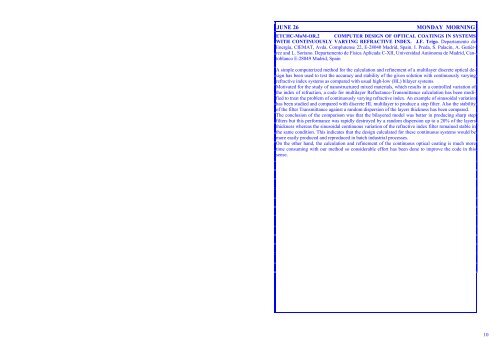Wüest M. 51 Wykes M. 82 Yamaguchi M. 17 Ybarra G. 129 Yubero F ...
Wüest M. 51 Wykes M. 82 Yamaguchi M. 17 Ybarra G. 129 Yubero F ...
Wüest M. 51 Wykes M. 82 Yamaguchi M. 17 Ybarra G. 129 Yubero F ...
Create successful ePaper yourself
Turn your PDF publications into a flip-book with our unique Google optimized e-Paper software.
JUNE 26 MONDAY MORNING<br />
ETCHC-MoM-OR.2 COMPUTER DESIGN OF OPTICAL COATINGS IN SYSTEMS<br />
WITH CONTINUOUSLY VARYING REFRACTIVE INDEX. J.F. Trigo. Departamento de<br />
Energía, CIEMAT, Avda. Complutense 22, E-28040 Madrid, Spain. I. Preda, S. Palacín, A. Gutiérrez<br />
and L. Soriano. Departamento de Física Aplicada C-XII, Universidad Autónoma de Madrid, Cantoblanco<br />
E-28049 Madrid, Spain<br />
A simple computerized method for the calculation and refinement of a multilayer discrete optical design<br />
has been used to test the accuracy and stability of the given solution with continuously varying<br />
refractive index systems as compared with usual high-low (HL) bilayer systems.<br />
Motivated for the study of nanostructured mixed materials, which results in a controlled variation of<br />
the index of refraction, a code for multilayer Reflectance-Transmittance calculation has been modified<br />
to treat the problem of continuously varying refractive index. An example of sinusoidal variation<br />
has been studied and compared with discrete HL multilayer to produce a step filter. Also the stability<br />
of the filter Transmittance against a random dispersion of the layers thickness has been compared.<br />
The conclusion of the comparison was that the bilayered model was better in producing sharp step<br />
filters but this performance was rapidly destroyed by a random dispersion up to a 20% of the layers<br />
thickness whereas the sinusoidal continuous variation of the refractive index filter remained stable in<br />
the same condition. This indicates that the design calculated for these continuous systems would be<br />
more easily produced and reproduced in batch industrial processes.<br />
On the other hand, the calculation and refinement of the continuous optical coating is much more<br />
time consuming with our method so considerable effort has been done to improve the code in this<br />
sense.<br />
10
















